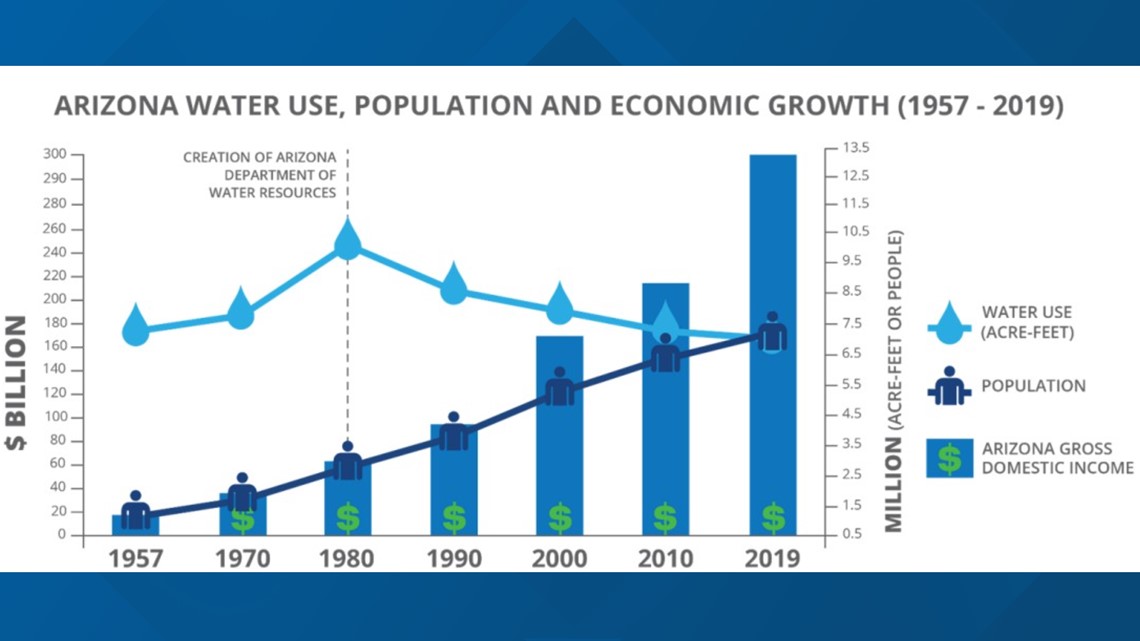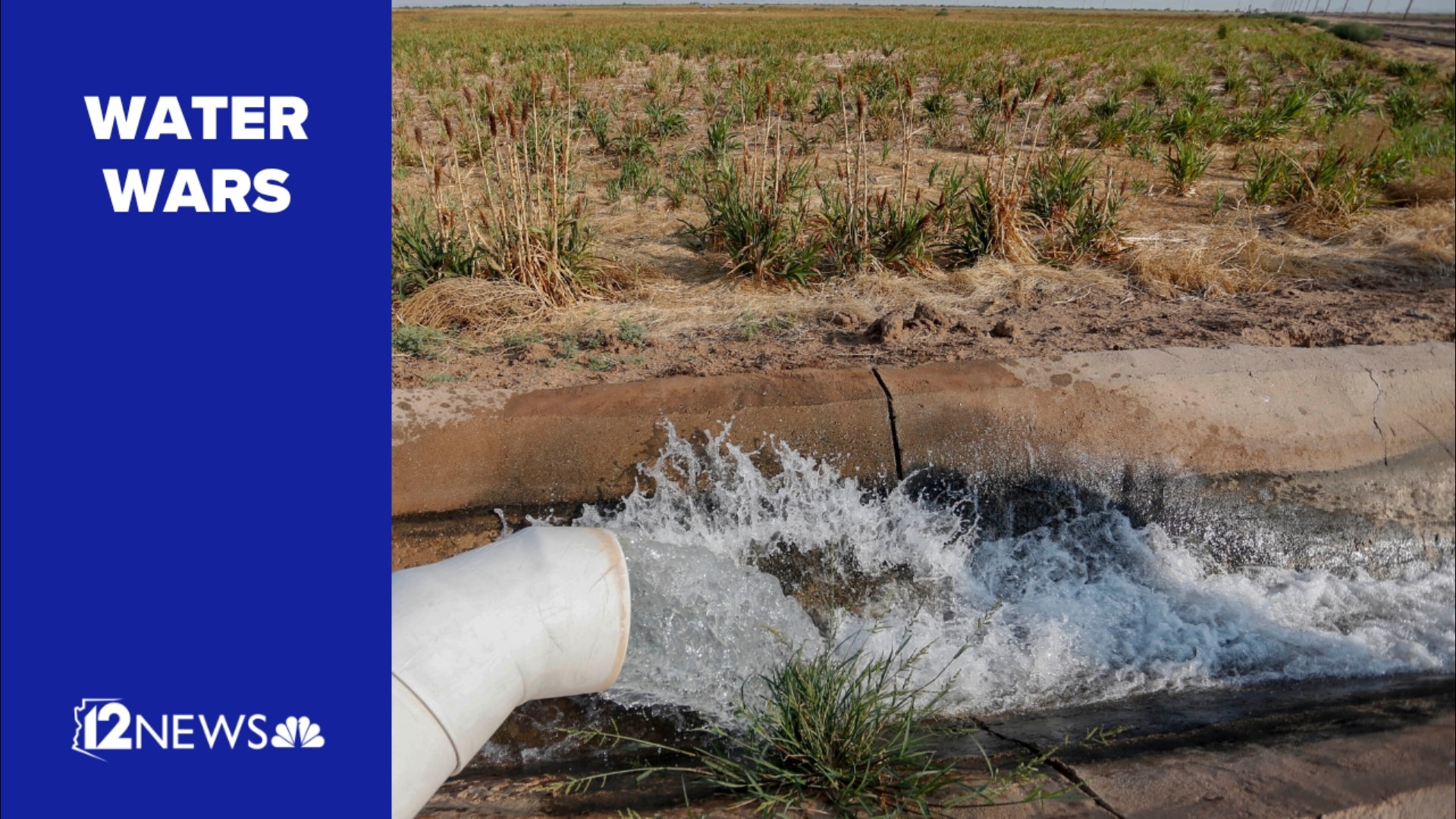PHOENIX — Arizona has excelled at banking water, storing 13 million acre-feet underground over the past 26 years. Other states along the Colorado River have apparently taken notice.
The notice has, unfortunately, come with "recommendations" from these states, pushing for Arizona to let its river water canals run dry and rely on that stored water, according to Arizona Department of Water Resources's Deputy Director Clint Chandler.
Chandler assured a crowded room full of Valley business leaders that the comments were said jokingly, but even if the comments did become serious in the future, the water in Central Arizona Project (CAP) canals wouldn't stop flowing.
Chandler and Sarah Porter, the Director of the Kyl Center for Water Policy at ASU, were the guests of honor at a meeting held by the Greater Phoenix Chamber of Commerce to inform the business leaders on the state's problems, solutions and expectations when it comes to water.
A theme of the presentation was why the Colorado River was in crisis, and why Arizona is not.
'Very, very solvable issue': Cities actively pursuing solutions to river cutbacks
The water problems Valley cities are facing are daunting, but have many more possible solutions to them compared to the climate-change-driven problems other cities are facing across the nation.
"Boston is trying to build a wall to hold back rising ocean levels. Houston is trying to figure out how to wrangle hurricanes," Porter said. "The problem of moving water to cities is extremely solvable."
Arizona's cities have partly proven they are capable of meeting these cutbacks head-on. Research has shown that areas around Maricopa, Pinal and Pima counties have already figured out how to reclaim ~95% of wastewater and recycle its usage.
Further investment into wastewater reclamation will be one of the major and first solutions moving forward, along with reducing the amount of water lost to evaporation and shipping water from other areas, according to the officials.
Other more technology-focused solutions, such as ocean water desalination, have a lot of environmental and technical problems that Porter says could take 30 to 50 years to address. In the meantime, she said there are much more opportunities to bring water from other places to the Phoenix and Tucson areas and stretch the water we already have through further conservation.
"The problem of water for cities like Phoenix and other cities in the West are currently facing...it's not easy, it's complex, but it's solvable," Porter said.
Arizona to shift greater focus on groundwater
While more ambitious solutions are put together, Arizona is expected to increase groundwater usage.
This news may sound alarm bells in the heads of people who know the state's water history. The state's supply was at risk of being drained dry back in the 70s, fueled mainly by the agriculture industry pumping out the resource at unsustainable rates.
The situation is worsened by research that shows the vast majority of water in aquifers across Arizona is around 10,000 years old, meaning the last time the aquifers were replenished was during the last ice age.
The CAP canals were made, in part, to avert this crisis.
As farmers are expected to take the brunt of the Bureau of Reclamation's most recently announced cuts, will groundwater once again be under threat?
The officials said no, and pointed to the state's vast amount of water savings and continuously bettering conservation practices as explanations of why.
"We're at the same water usage today than we were in 1957, although the size of the state's economy has grown by more than 2,000% and our population has grown by 555%," Chandler said.


There are multiple upcoming and ongoing situations that may change groundwater's status in the state, including the ongoing situation in the Pinal AMA halting development and the prospect of two new AMAs being developed in Cochise County.
In spite of the coming challenges, however, the officials regarded using groundwater in combination with other solutions to be a winning bet.
"I don't love relying on groundwater as a new water supply, but, I'll admit, it can be a good part of a municipal water portfolio, especially when combined with reuse and aggressive conservation," Porter said.
California didn't get cut, but they'll be in crisis much sooner than Arizona
One of the other biggest talking points at the presentation was not on Arizona, but its neighboring state of California. Specifically, why The Golden State isn't seeing any cuts in Colorado River water, even though the state uses the most river water by far.
The answer, again, relates to the nation's history of water rights and Arizona's seemingly superior water management decisions.
Arizona's river water delivery system, the CAP canal, faced a huge legal battle with California when it was first constructed. Arizona ended up winning big in that it was allowed to construct the canal, but had to get lower-priority rights as part of a compromise.
"In order to enable the construction of the CAP canal, Arizona...had to agree that their project would take junior priority status to California," Chandler said. "That's why California, for now, won't participate [in the cuts]."
Even though California isn't getting cut, the water situation in the state is more dire than in Arizona. The reason why comes down to where the states decided to bank their extra water.
Arizona made the decision decades ago to start storing its excess river water underground. The Metropolitan Water District of Southern California, which is made up of Los Angeles, Orange, San Diego, Riverside, San Bernardino and Ventura counties, decided instead to store its excess river water back in Lake Mead, which is now at its lowest water levels since originally being filled.
It's this reason why Los Angeles has a water usage policing agency while Phoenix only recommends residents cut back on watering their lawns and filling their pools.
"California...is in a tough spot. They rely on the State Water Project, like bringing water from Northern California to Southern California, but that's failing," Chandler said. "Usually it's at about 60% allocation, but recently it's been at about 5%. They've gone into restrictions...because they don't have any other water source."
Water Wars
Water levels are dwindling across the Southwest as the megadrought continues. Here's how Arizona and local communities are being affected.

